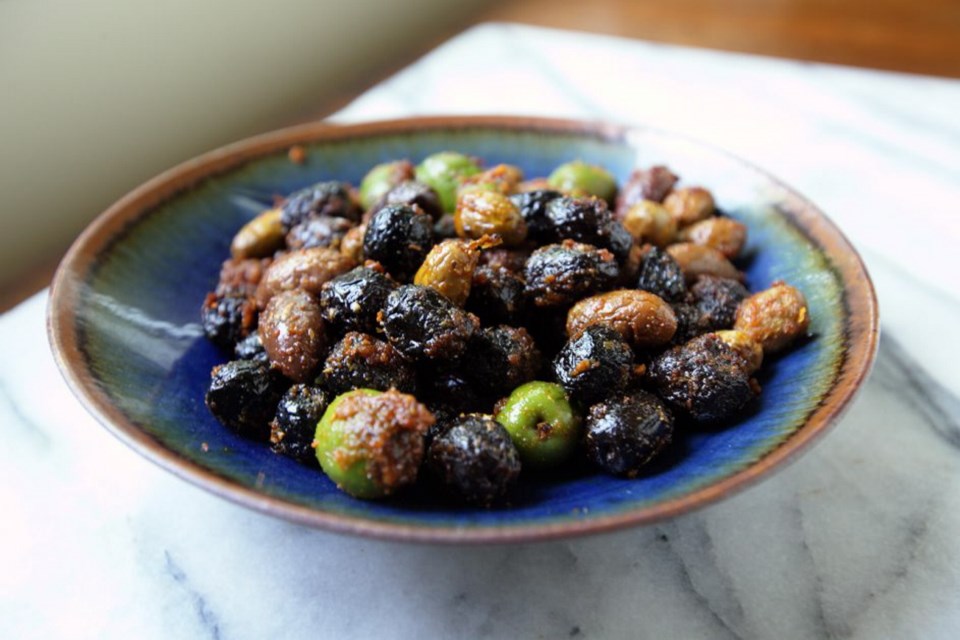 In a recent Ask Eric Sunday column, I answered a query about storing olives. When doing research for that story, I reaffirmed something I already knew. There are many types of olives and you can buy a nice variety of them right here Victoria.
In a recent Ask Eric Sunday column, I answered a query about storing olives. When doing research for that story, I reaffirmed something I already knew. There are many types of olives and you can buy a nice variety of them right here Victoria.
Both findings were not surprising. According to the website of the olive oil information provider The Olive Oil Source, oliveoilsource.com, olive trees, native to the Mediterranean region, are among the oldest known cultivated trees in the world, having been grown before the written language was invented.
During the many centuries olive trees have been around, different types were developed, resulting in trees that yielded olives of different sizes and tastes.
Some decided it was best to pick those olives when underripe and green. Others thought the fruit was better when harvested ripe and darker in colour. Different methods for curing, brining and preserving those olives were also developed.
The result is numerous types of fine-tasting olives that folks around the world happily gobble up. Below are brief descriptions of seven types I found for sale in Victoria, followed by a tasty recipe for roasted olives.
Sun-dried Moroccan Olives
These black olives are dry-cured in salt and lightly coated with olive oil. The no-brine curing gives them an intense — some would say addictive — flavour and a prune-like appearance. Enjoy as is, serve them with cured meats and cheese, or add them to other dishes, such as a salad or tangine.
French Picholine Olives
This brine-fermented, small, almond-shaped green olive is grown in places such as Provence. They have a nutty, briny, fruity flavour and a crisp texture, making them nice to snack on or use in a cocktail, such as a martini.
Sicilian Castelvetrano Olives
These large, meaty, almost buttery olives are grown in Sicily, near the town of Castelvetrano. Like some other types of olives, after harvesting the fruit is washed in lye (caustic soda), removing bitterness. After thorough rinsing, the olive is either refrigerated or canned. This process retains the olive’s striking green colour. Enjoy as is or with such things as almonds, cured meats and cheeses, such as mozzarella di bufala.
Italian Calabrese Olives
These, firm, almost crunchy green olives come from Italy’s Calabria region and have a distinctive sharp, acidic flavour. They are sometimes flavoured with complementary tastes, such as garlic, hot pepper and fennel. You can enjoy them on their own, but they also pair well with foods you may find on an antipasto platter.
French Niçoise Olives
These deep brown to black olives, with a fragrant, herbaceous aroma, are one of smallest cultivated types. They are grown in places such as the Cote d’Azur region of France. Despite their size, they have a big flavour, with some bitterness, sweetness and licorice all in the mix. Enjoy them on their own or use them in recipes, such as the classic French creations salad niçoise and tapenade.
Stuffed Spanish queen green olives
These aromatic green olives are also called gordal olives. Gordal in Spanish means “fat” or “big,” a good way to describe these richly flavoured plump olives. Because of their size, they are perfect to pit and stuff with such things as pimento. These olives are great on their own and also perfect for a meat and cheese tray or martini.
Greek kalamata olives
This almond-shaped, deep-purple olive is named after the Greek city of Kalamata. They are brined and flavoured with such things as herbs and wine vinegar, giving them a robust, fruity and rewarding flavour. Enjoy them as is or add to such things as a salad or braised meat dishes.
Note: If you missed my article on storing olives, you can find it on timescolonist.com.
Spice-roasted Olives
Olives, nicely spiced, roasted and served warm as a snack or appetizer. Be sure to use an interesting mix of black and green olives for this, such as some of those written about today. If you’re serving these to guests, pop them into the oven shortly after they arrive. Your house will soon fill with the most amazing aroma and they’ll find it hard to resist these when ready.
Preparation: A few minutes
Cooking time: 20 minutes
Makes: About 7 (1/3 cup) servings
2 1/2 cups mixed, green and black, unpitted olives, drained well if in brine
1/2 tsp ground fennel seed
1/2 tsp crushed chili flakes
1/2 tsp ground cumin
1/2 tsp paprika
1/2 tsp dried oregano
1/4 tsp garlic powder
3 Tbsp extra virgin olive oil
1/2 tsp finely grated orange zest
2 Tbsp orange juice
1/2 tsp finely grated lemon zest
2 Tbsp lemon juice
• freshly ground black pepper to taste
Preheat the oven to 450 F. Place all ingredients in a bowl and toss to combine.
Spoon olives and their liquid into a 10-inch cast iron skillet or other ovenproof pan. Roast the olives for 20 minutes, shaking the pan once or twice. Let olives cool a few minutes, and then spoon into a serving dish and serve warm.
Eric Akis is the author of eight cookbooks. His latest is The Great Rotisserie Chicken Cookbook (Appetite by Random House). His columns appear in the Life section Wednesday and Sunday.



